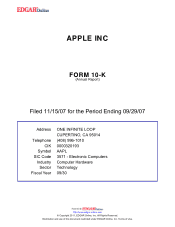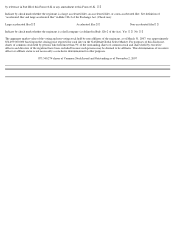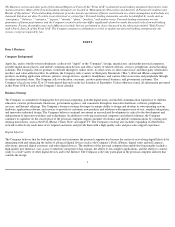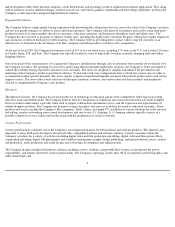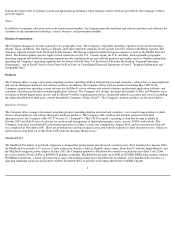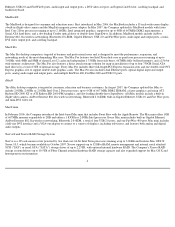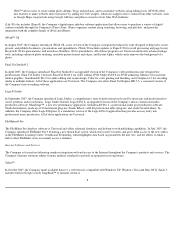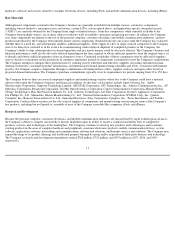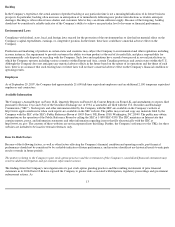Apple 2007 Annual Report Download - page 6
Download and view the complete annual report
Please find page 6 of the 2007 Apple annual report below. You can navigate through the pages in the report by either clicking on the pages listed below, or by using the keyword search tool below to find specific information within the annual report.
features developer tools to optimize system and application performance when running creative solutions provided by the Company or third-
party developers.
Other
In addition to consumer, education and creative professional markets, the Company provides hardware and software products and solutions for
customers in the information technology, science, business, and government markets.
Business Organization
The Company manages its business primarily on a geographic basis. The Company's reportable operating segments consist of the Americas,
Europe, Japan, and Retail. The Americas, Europe, and Japan reportable segments do not include activities related to the Retail segment. The
Americas segment includes both North and South America. The Europe segment includes European countries as well as the Middle East and
Africa. The Retail segment operates Apple-owned retail stores in the U.S., Canada, Japan, the U.K. and Italy. Each reportable geographic
operating segment and the Retail operating segment provide similar hardware and software products and similar services. Further information
regarding the Company's operating segments may be found in Part II, Item 7 of this Form 10-K under the heading "Segment Operating
Performance," and in Part II, Item 8 of this Form 10-K in Notes to Consolidated Financial Statements at Note 9, "Segment Information and
Geographic Data."
Products
The Company offers a range of personal computing products including desktop and portable personal computers, related devices and peripherals,
and various third-party hardware and software products. In addition, the Company offers software products including Mac OS® X, the
Company's proprietary operating system software for the Mac®; server software and related solutions; professional application software; and
consumer, education and business oriented application software. The Company also designs, develops and markets to Mac and Windows users
its family of iPod® digital music players and its iPhone™ mobile communication device, along with related accessories and services including
the online distribution of third-party content through the Company's iTunes Store™. The Company's primary products are discussed below.
Hardware Products
The Company offers a range of personal computing products including desktop and notebook computers, server and storage products, related
devices and peripherals, and various third-party hardware products. The Company's Mac desktop and portable systems feature Intel
microprocessors, the Company's Mac OS X Version 10.5 Leopard™ ("Mac OS X Leopard") operating system that became available in
October 2007 and iLife® suite of software for creation and management of digital photography, music, movies, DVDs, and website. The
Company's transition from PowerPC to Intel microprocessors for Mac systems was completed in August 2006, and its transition for Xserve®
was completed in November 2006. There are potential risks and uncertainties associated with the transition to Intel microprocessors, which are
further discussed in Item 1A of this Form 10-K under the heading "Risk Factors."
MacBook® Pro
The MacBook Pro family of notebook computers is designed for professionals and advanced consumer users. First introduced in January 2006,
the MacBook Pro includes a 15-inch or 17-inch widescreen display, a built-in iSight® video camera, Front Row™ with the Apple Remote, and
the MagSafe® magnetic power adapter. In June 2007, the Company updated its MacBook Pro models to include the latest Intel Core 2 Duo
processors and the Nvidia GeForce 8600M GT graphics controller. MacBook Pro includes up to 4GB of 667MHz DDR2 main memory with an
800 MHz frontside bus, a Serial ATA hard drive, and a slot-loading double-layer SuperDrive®. In addition, every MacBook Pro features a 1-
inch thin aluminum enclosure and includes AirPort Extreme® 802.11n wireless networking, Bluetooth 2.0+EDR, Gigabit
3

